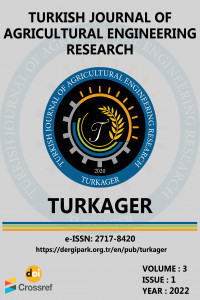Mathematically Predicting the Performance Rate of Plow-Type Trenchless Machine
Mathematically Predicting the Performance Rate of Plow-Type Trenchless Machine
Mathematical analysis, Modeling, Performance rate, Plow Trenchless,
___
- Baek SY, Baek SM, Jeon HH, Kim WS, Kim YS, Sim TY, Sim TY, Choi KH, Hong SJ and Kim YJ (2022). Traction performance evaluation of the electric all-wheel-drive tractor. Sensors, 22(3): 785. https://doi.org/10.3390/s22030785
- Das BM and Luo Z (2016). Principles of soil dynamics. Cengage Learning.
- Diep DD (2017). Analysis the factors affecting conveyance rate of unbucket chain trenching machine. In Agricultural, Forest and Transport Machinery and Technologies, 4(1): 38-44.
- Ghonimy M (2021). Prediction the performance rate of chain type trenching machine. In Turkish Journal of Agricultural Engineering Research, 2(2): 390-402. https://doi.org/10.46592/turkager.2021.v02i02.012
- Ghonimy M, Abd El Rahman E and Alzoheiry A (2022). Mathematical prediction of excavating force and power of chain type trenching machine. Acta Technologica Agriculturae, 25(4): 197-204. https://doi.org/10.2478/ata-2022-0029
- Ghonimy M, Morcos MA, and Badr AE (2023). Mathematical analysis for prediction performance rate of wheel type trenching machine. Journal of Agricultural Machinery, 13(1): 1-13. https://doi.org/10.22067/jam.2021.71081.1049
- Islam MN, Iqbal MZ, Kabir MSN, Jung KY, Mun DH and Chung SO (2019). Performance evaluation of trenchless subsurface drainage piping machine. Journal of Biosystems Engineering, 44(4): 218-225.
- Jia J, Jia and Schmidt (2018). Soil dynamics and foundation modeling. New York: Springer.
- Kepner RA, Bainer R and Barger EL (2017). Principles of Farm Machinery. Published by Satish Kumar Jain and produced by Varun Jain for CBS Publishers & Distributors Pvt. Ltd.
- Naghshbandi SN, Varga L and Hu Y (2021). Technologies for safe and resilient earthmoving operations: A systematic literature review. Automation in Construction, 125: 103632. https://doi.org/10.1016/j.autcon.2021.103632
- Ranjbarian S, Askari M, and Jannatkhah J (2017). Performance of tractor and tillage implements in clay soil. Journal of the Saudi Society of Agricultural Sciences, 16(2): 154-162. https://doi.org/10.1016/j.jssas.2015.05.003
- Reddy Y and Shailesh P (2018). Design and analysis of excavator bucket tooth. In International Journal of Modern Trends in Engineering and Research, 5(4): 79-86.
- Revenko VU, Ivanov AB, and Petukhov DA (2022, June). Power balance of all-wheel drive mobile power vehicle. In IOP Conference Series: Earth and Environmental Science, 1045(1): 012080. IOP Publishing. https://doi.org/10.1088/1755-1315/1045/1/012080
- Rokochinskiy A, Jeznach J, Volk P, Turcheniuk V, Frolenkova N and Koptiuk R (2019). Reclamation projects development improvement technology considering optimization of drained lands water regulation based on BIM. Przegląd Naukowy. Inżynieria i Kształtowanie Środowiska, 28(3): 85. https://doi.org/10.22630/PNIKS.2019.28.3.40
- Sitorus PE, Ko JH and Kwon OS (2016). Parameter study of chain trenching machines of underwater construction robots via analytical model. In OCEANS 2016 MTS/IEEE Monterey. Monterey, CA, USA: IEEE, pp. 1–6. ISBN: 978-1-5090-1537-5. https://doi.org/10.1109/OCEANS.2016.7761072
- Srivastava AK, Goering CE, Rohrbach RP and Buckmaster DR (2006). Engineering principles of agricultural machines. 2nd ed., pp. i-xiv. St. Joseph, Michigan: ASABE. Copyright 2006 American Society of Agricultural and Biological Engineers, St. Joseph, Mich.
- Yayın Aralığı: Yılda 2 Sayı
- Başlangıç: 2020
- Yayıncı: Ebubekir ALTUNTAŞ
Development and Performance Evaluation of a Hand Operated Maize Sheller
Muyıwa OKUSANYA, Francis AGBONGİABAN
Abdelgawad SAAD, Hani MANSOUR, Elsayed ALİ, Mostafa AZAM
Uğur ÖZKAN, Nesim YILDIZ, Celal PEKER
Maney Ayalew DESTA, Getachew Shunki TİBBA, Mubarek Mohammed ISSA, Wariso HEYİ
A microcontroller - Based Irrigation Scheduling Using FAO Penman-Monteith Equation
Olugbenga Kayode OGİDAN, Samuel Dare OLUWAGBAYIDE, Thomas ALE
Mathematically Predicting the Performance Rate of Plow-Type Trenchless Machine
Development of a Cowpea Threshing Machine
Mohamed MANSOUR SHALABY REFAAAY, Ahmed SHAWKY EL-SAYED, Mokhtar COTTB AHMED AWAD
Simulation-Optimization Modelling of Yield and Yield Components of Tomato Crop
Nura Jafar SHANONO, Lawal AHMAD, Nuraddeen Mukhtar NASİDİ, Abdul'aziz Nuhu JİBRİL, Mukhtar Nuhu YAHYA
